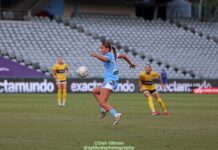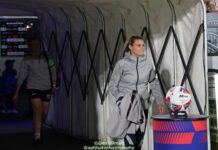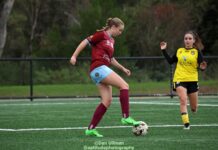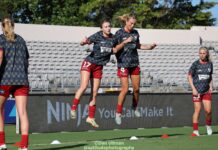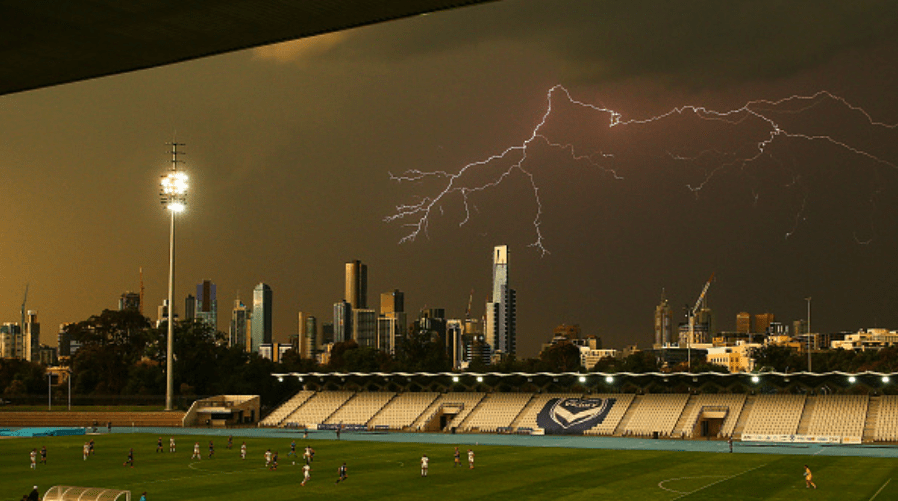
With Melbourne City’s recently announced south-east relocation the W-League will be played at the 18th different Victorian venue in the competition’s history this summer.
No, that is not a typo – the number really is 18.
So why has finding a “home” plagued both Victorian clubs and been such an issue for the W-League in Victoria? Fox Sports commentator Teo Pellizzeri takes a closer look.
The South East has a new home of football! 🏠⚽
We are excited to announce our relocation to a brand-new Etihad City Football Academy at Casey Fields.
Full details: https://t.co/KLvcInBSXD@CityOfCasey @greaterdandy pic.twitter.com/wwHkT2Pz4D
— Melbourne City FC (@MelbourneCity) December 14, 2020
Cavernous Arenas
Since season one, W-League has had the occasional presence at Docklands Stadium, be it under the name of Telstra Dome, Etihad or Marvel. Both standalone and double-headers started at AAMI Park in late 2010. Pre-redevelopment Kardinia Park (then capacity 29,500) was also used 2011-2014, in some instances entirely forced by the needs of television.
With only a few notable exceptions, these venues have been too big. A few hundred fans were outnumbered by tens of thousands of empty seats. Even Lakeside Stadium at 7400 seated feels oversized as only meagre attendances have turned out since 2504 did for the 2014 Grand Final at the venue.
When Melbourne Victory’s A-League crowds and active fans were better, double-headers rarely captured the numbers, as pre-game catch-ups and marches meant fans arrived after the “curtain raiser” was over. While a generous cut-off time allowed Victory to claim a crowd of 14,068 for a Docklands game against Canberra in 2014, only one really great instance of a Victory double-header being beneficial stands out. That came in January 2014 when the North Terrace had already entered the venue in time to cheer for Beattie Goad’s second-half goal against Western Sydney Wanderers.
The only other successful double-header came in January 2016 when City went to penalties with Brisbane Roar in the semi-final. The crowd for the following A-League game was only 10,825, but the majority were in place as the W-League semi ran long. To put that number in context, standalone grand finals at AAMI Park have drawn 4181 (Victory in January 2013), 4206 (City in January 2016), and obviously last season nought.
No Longer Standing
Victory has consistently used Lakeside Stadium since the venue was redeveloped in 2013, albeit without ever making it feel like home. Prior to the 2011 redevelopment, they did play a handful of games at the old pre-running track and more intimate Bob Jane Stadium.
Another venue no longer standing is Olympic Park, which Victory played at in 2009. It too was oversized for the attendances, and has since been replaced by Collingwood’s training centre and football oval used for AFLW games.
Suburban Struggles
So to the suburban tour, which occasionally captured lightning in a bottle but has largely underwhelmed. Especially compared to Sydney where the once-a-season trip to Seymour Shaw in the Shire or Cromer Park in Manly is seen as, and attended like, a major event.
From Broadmeadows Valley Park, to CB Smith Reserve in Fawkner, and in particular Epping Stadium in the city’s far northern suburbs, venues prohibitive to non-drivers have been characteristic.
The biggest success story was Wembley Park in Box Hill. For a handful of games in 2012-13 Victory struck gold, and perhaps tellingly went undefeated winning three from four. It had the right mix of somewhat central location (inner-east), and the perfect size venue to make modest sub-1000 crowds feel significant. It also aligned with Jess Fishlock’s Victory debut and the team’s run to its first grand final, leaving the venue a sentimental favourite that coincided with one of the most exciting times in the club’s history. Why did they never return? From grass disease, to rehabilitation work in the off-season to prepare it for heavy traffic in winter, the venue was never again on the table as an option.
Victory tried to replicate something similar a bit further out in the south east, at Kingston Heath in Cheltenham. A venue that has been a regular in the national rounds of the FFA Cup. But by December 2015, using the pitch in summer was again taking its toll. So Victory resorted to a venue they’d tried to avoid, the synthetic at Veneto Club in Bulleen. While the occasional game had been played at Veneto Club in the first four seasons, one fateful game in October 2012 spooked Victory from using the venue. In that match against Brisbane Roar, Victory lost both at-the-time Matilda Ash Brown and former Matilda Louisa Bisby to ACL injuries in quick succession.
But the Kingston Heath situation forced Victory back to the Veneto Club, injury free, for two games in December 2015. The synthetic has since been relaid but the W-League has not returned. The cruel irony is the venue is, like Wembley Park, perfectly sized, somewhat centrally placed and is in a heartland of junior participation.
Melbourne City has made a narrower range of choices for their suburban venues, primarily using CB Smith Reserve in Fawkner. For those that haven’t been, there is a light tower between the grandstand and pitch, parking becomes hectic once the crowd is more than a few hundred and it is not close to public transport. City playing dazzling football, winning every game, with world class names like Little, Fishlock and de Vanna, couldn’t increase the attendances.
Hume City’s ABD Stadium at Broadmeadows Valley Park has also been used in a nonpartisan fashion by both Victory and City since 2013, mainly due to the quality of pitch, accommodating host club Hume City, and in more recent times, suitability for televised games. Like Epping Stadium, its location in the far north and proximity to public transport has been seen as prohibitive to fans.
The lowest point of scouring for venues came in January 2018, when City was granted permission to use their City Football Academy training pitch in Bundoora as a one-off for a game against Perth Glory. Seating capacity zero. Fans stood behind a high fence, the camera operator stood on top of his car to get elevation. Somehow the crowd has been calculated as 508 in the history books but don’t take it as gospel.
Regional Tours
Both City and Victory have tried their hand at taking games to regional centres, but haven’t been backed by the crowds to make it a must. In 2009, Victory took a game to Shepparton at football oval Deakin Reserve, while last year City went to the town to play at the redeveloped McEwen Reserve soccer complex. Victory will also head back to former NSL venue La Trobe City Stadium in Morwell for a fourth time this summer, having first played a game there in 2010. Bendigo, at one point enough of a soccer stronghold to field a team in the top women’s state league, has never hosted a game, while Ballarat (in spite of hosting the Matildas in 2016) and Albury-Wodonga are both yet to receive their first W-League visit. Victory’s flirtation with taking A-League games to Tasmania is also yet to extend to the W-League.
The Future
So now that ‘TBC’ on the draw is set to be filled by Frank Holohan Soccer Complex for Melbourne City’s home games this summer, what can we expect?
City’s south-east swing is one of great intrigue, and the same criticisms levelled at Epping, Fawkner or Broadmeadows can be equally applied by those geographically disadvantaged by getting to Endeavour Hills now. The ground is different in that the main grandstand is behind the goals, while a hill is the best view from side-on. Host club Dandenong City running the kitchen will guarantee the best food the W-League has seen.
City’s commitment to engaging the South Eastern suburbs as part of their broader relocation strategy could be the game-changer in boosting attendance. Being serial winners couldn’t do it, having superstars from Catley to Carpenter couldn’t do it, so now that sense of belonging and local connection might be the answer.
Victory will continue to use Lakeside this summer, but the attendances speak for themselves. An appropriately sized venue is its own drawcard from the game day experience it creates, and even though this will be the eighth successive season of games at Albert Park, it’s not home.
John Caine Memorial Park in Thornbury, used just once in 2011, has a bit of that Wembley Park mystique to it and has been thrown up (by me) in “what about” conversations when talking about prospective venues. But if the W-League ever does return to the inner north, it will surely be after Heidelberg United’s Olympic Village redevelopment is completed. A proven winner drawing crowds in the FFA Cup, the new-look Village could be the appropriately sized and placed answer for Victory in years to come.
W-League hasn’t been to Geelong since December 2014 and Western United’s recent declaration of intent suggest Victory and City won’t be gatecrashing the seemingly set-aside territory of the western suburbs and beyond.
Western Melbourne Group received their A-League license on the back of a bid underpinned by building their own stadium, while Western United has since announced a 5000-seat secondary venue at their proposed training facility.
Western delivering on its promise of building venues and establishing “home” as one of their first W-League actions would give it something their two nearest rivals are still, after years of participation, ironing out.
Follow all our W-League coverage.


